
Relying on one software provider for all of your security needs isn’t enough. It’s key that who you get your antivirus software from, is different from who you get your firewall from, is different from… You get the idea.
To understand why, you need to understand how security software works. Let’s take antivirus software, also known as anti-malware solutions. Here are three methods anti-malware software most commonly use:
Signatures
The oldest and most reactionary of methods, signature-based or “dictionary” detection looks for a malicious program’s specific digital code, comparing it to a database of known threats.
The downside to this method is that it’s not very useful against new threats. It requires at least one person or system to be attacked by the malicious software and identify it as malware before everyone else can be protected against it.
With hundreds of thousands of new malware threats being created every day, more is needed to keep modern systems safe.
Behavioral detection
A more modern technique for identifying known and unknown viruses and malware, behavioral detection looks at what software does as opposed to what it is.
Viruses and other malicious programs tend to perform functions that aren’t typical of a human user, like attempting to shut down or bypass anti-virus solutions on the system, automatically running every time you startup your system, or contacting an external server to download other malicious software.
Suspicious behaviors like these, or even the potential for applications to perform them, triggers behavioral detection, effectively warning your system: Danger, Will Robinson, danger! (For any of you young pups that don’t get the reference, check out this video or watch Netflix’s updated version of the classic, Lost in Space.)
“Although there is greater potential for false positives with behavioral detection than signatures, it’s a crucial component in the antivirus puzzle,” this Digital Trends article explains. “Ransomware attacks that encrypt files and demand payment to unlock them require a fast response and signatures alone would be unlikely to stop it.”
Machine learning
Essentially an artificial intelligence (AI) solution, machine learning teaches your computer to analyze application codes, comparing it to its understanding of malicious and benign programs to determine whether a software is dangerous or not. When used in conjunction with other security protocols, machine learning has proven effective at combating threats new and old.
Machine learning leverages cloud-connected databases of information from which it draws to detect malicious software. However, it is able to adjust more quickly than more human-curated methods of malware protection, better keeping up to date with the ever-evolving threat landscape.
Each method taps databases of historical data, threat signatures, suspicious behavior, and the like.
And each security software provider (think Norton, McAfee, etc.) maintains its own database of malware and other firewall threats. There will be overlap between providers, but there is also a range of data and knowledge that each provider will gather ahead of the others. As quickly as malware is created, a day—even a few hours—can make a world of difference.
By working across multiple solutions, you combine the rapidly-evolving knowledge databases of each of them, covering a wider range of security threats. And although any cyber security solution worth its salt includes remediation, or disaster recovery, solutions, prevention is so much more satisfying.
Future Link IT takes a layered approach to cybersecurity, partnering with multiple providers to cover all your security bases—so you focus on the priorities that move your business forward. To get a security assessment of your current strengths and vulnerabilities, fill out this form and one of our team of experts will reach out to you right away.

